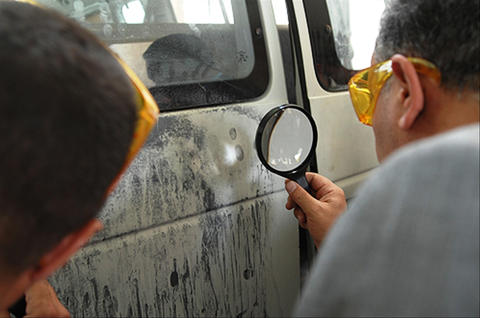
Law enforcement officers locating latent fingerprints on the side of a van.
A new report by the National Institute of Standards and Technology (NIST) and the Department of Justice's National Institute of Justice (NIJ) has documented 149 potential sources of human error in the analysis of crime scene fingerprints. The study by a working group of 34 experts recommends a series of improvements to significantly reduce or eliminate the errors, based on the findings from its three-year scientific assessment of the effects of human factors on forensic latent print analysis. The working group consisted of experts from various forensic disciplines, statisticians, psychologists, engineers and other scientific experts, as well as legal scholars and representatives of professional organizations.
For more than a century, the most reliable and legally accepted method for identifying the perpetrator of a crime has been to compare latent fingerprints—those left by chance or accident at a crime scene—to known (or exemplar) prints on file. However, several high-profile cases in the United States and abroad during the past 20 years have shown that forensic examiners can sometimes make mistakes when analyzing or comparing prints, or even in communicating findings to law enforcement officials or juries. Such errors can be devastating, resulting in missed opportunities to identify the guilty or wrongful convictions of the innocent.
As with any laboratory procedure, there are a multitude of human factors that can influence the results of latent print analysis—examples include inadequate training, poor judgment, vision limitations, lack of sleep and stress. The chances of error increase if the examiner also must deal with organizational factors such as a lack of standards or quality control, poor management, insufficient resources or substandard working conditions (such as bad lighting). The Expert Working Group on Human Factors in Latent Print Analysis was convened in December 2008 to study these factors for the first time using an evidence-based, scientific review of literature, case studies and previous analyses; and then draw on the knowledge gained to estimate the incidence, severity and costs of errors; evaluate approaches to reducing errors and identify the most effective; and promote best practices through a national agenda for error reduction.
Much of the report provides a comprehensive discussion of these factors and how they relate to all aspects of latent print examinations, from acquisition of evidence through communicating results in documents and testimony. Based on what it learned, the working group outlined 34 recommendations addressing the problems resulting from human error. Among the proposed improvements:
- Urging management at forensic service provider facilities to foster a culture in which it is understood that some human error is inevitable and that openness about errors leads to improvements in practice;
- Documenting latent print examinations at a detail level that would permit another examiner to assess the accuracy and validity of the work;
- Requiring agencies that employ latent print examiners to establish requirements and guidelines for reporting, documentation and testimony that are reviewed for each examiner at least annually; and
- Intensely preparing print examiners and other forensic experts to give credible and accurate testimony in trials, stressing skills such as using lay language, creating visuals that can easily be understood, and thinking clearly under cross-examination.
The working group also identified a number of future steps that should be taken to advance the error reduction effort, including: prerequisite educational and skill standards for examiner training; continuing education, mentoring and accreditation/certification programs; research to integrate automated systems into the early stages of print analysis; and a comprehensive testing program for ensuring examiner competency and proficiency.
The report, Latent Print Examination and Human Factors: Improving the Practice through a Systems Approach (NIST Interagency Report 7842) is available online.

